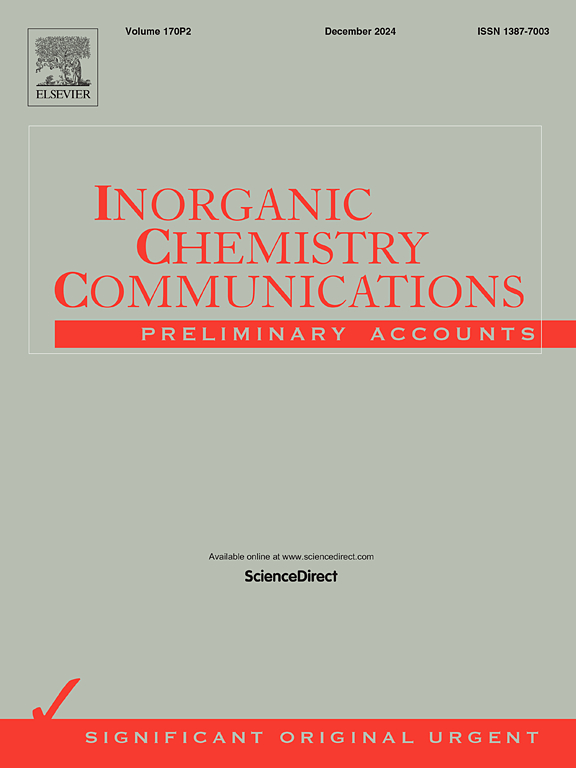A new zinc(II) trinuclear heteroleptic coordination compound derived from zinc acetate and N-salicylidenecyclohexylamine
IF 4.4
3区 化学
Q1 CHEMISTRY, INORGANIC & NUCLEAR
引用次数: 0
Abstract
We report on a one-pot reaction of a mixture of cyclohexylamine and salicylaldehyde with a half of equivalent of Zn(OAc)2 in EtOH, which allowed to produce a novel discrete trinuclear heteroleptic complex [Zn3L2(OAc)4] (1), where L is a monodeprotonated anion of N-cyclohexylsalicylideneimine (HL). Notably, our numerous attempts to produce the previously reported discrete mononuclear homoleptic complex [ZnL2] using both the reported and a series of the modified by us synthetic approaches failed, and complex 1 was the exclusively isolated product. These findings cannot be explained at the moment. The molecular structure of 1 is centrosymmetric and comprises a trinuclear central Zn36+ cationic backbone. The terminal metal cations are coordinated by the imine nitrogen atom and phenolate oxygen atoms of one ligand L, and by two oxygen atoms of two acetate anions, yielding a distorted NO3 tetrahedral coordination environment. The central metal cation is coordinated by two phenolate oxygen atoms from two ligands L and by four oxygen atoms of four acetate anions, yielding a slightly distorted O6 coordination environment. Thus, both the L and acetate anions in the structure of 1 serve as bridging ligands linking two Zn2+ cations. The crystal packing of 1 was studied in detail by the Hirshfeld surface analysis. A solution of 1 in DMSO absorbs from 250 nm to about 420 nm with two clearly defined bands centered at 273 and 368 nm due to intraligand transitions within L and the acetate anions. The DFT-based calculations were also applied to shed light on the structural and optical features of 1. A molecular docking approach revealed that 1 can potentially inhibit hemoglobin S with the so-called ligand efficiency scores being within the recommended ranges for a drug, although some parameters are slightly out of the recommended ranges.

由醋酸锌和 N-水杨基亚癸基环己胺衍生的一种新的锌(II)三核异性配位化合物
我们报道了一种环己胺和水杨醛的混合物与一半当量的Zn(OAc)2在EtOH中的一锅反应,可以产生一种新的离散三核杂电络合物[Zn3L2(OAc)4](1),其中L是n -环己基水杨基亚胺(HL)的单去质子阴离子。值得注意的是,我们多次尝试使用已报道的和一系列经过我们修饰的合成方法来生产先前报道的离散单核同感复合物[ZnL2],但都失败了,复合物1是唯一分离的产物。这些发现目前还无法解释。1的分子结构是中心对称的,包括一个三核中心Zn36+阳离子主链。末端金属阳离子由一个配体L的亚胺氮原子和酚酸氧原子以及两个醋酸阴离子的两个氧原子配位,形成一个扭曲的NO3四面体配位环境。中心金属阳离子由来自两个配体L的两个酚酸氧原子和四个醋酸阴离子的四个氧原子配位,产生轻微扭曲的O6配位环境。因此,1结构中的L和乙酸阴离子都是连接两个Zn2+阳离子的桥接配体。采用赫希菲尔德表面分析法对1的晶体堆积进行了详细的研究。1在DMSO中的溶液在250 nm到420 nm的范围内吸收,由于L和乙酸阴离子的配体内跃迁,在273和368nm处有两个清晰的条带。基于dft的计算也被应用于揭示1的结构和光学特征。分子对接方法显示,1可能抑制血红蛋白S,其所谓的配体效率评分在药物推荐范围内,尽管某些参数略超出推荐范围。
本文章由计算机程序翻译,如有差异,请以英文原文为准。
求助全文
约1分钟内获得全文
求助全文
来源期刊

Inorganic Chemistry Communications
化学-无机化学与核化学
CiteScore
5.50
自引率
7.90%
发文量
1013
审稿时长
53 days
期刊介绍:
Launched in January 1998, Inorganic Chemistry Communications is an international journal dedicated to the rapid publication of short communications in the major areas of inorganic, organometallic and supramolecular chemistry. Topics include synthetic and reaction chemistry, kinetics and mechanisms of reactions, bioinorganic chemistry, photochemistry and the use of metal and organometallic compounds in stoichiometric and catalytic synthesis or organic compounds.
 求助内容:
求助内容: 应助结果提醒方式:
应助结果提醒方式:


